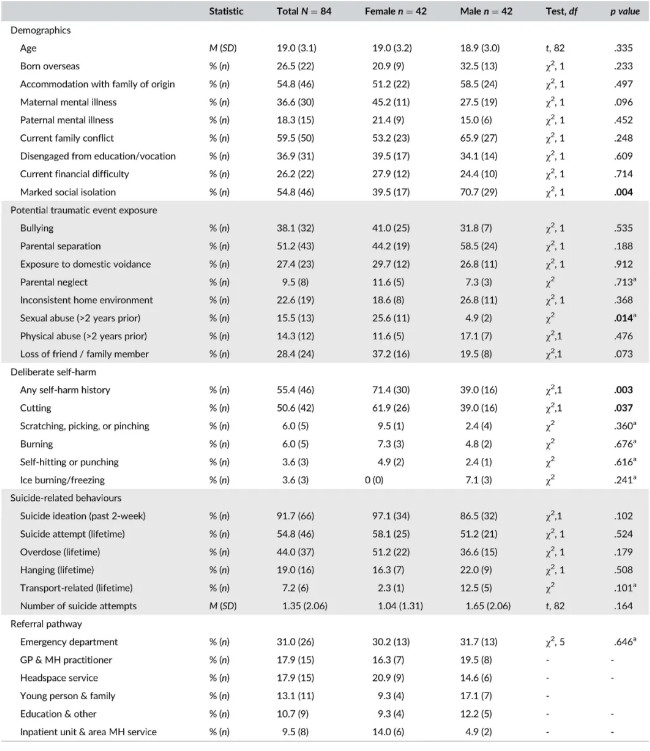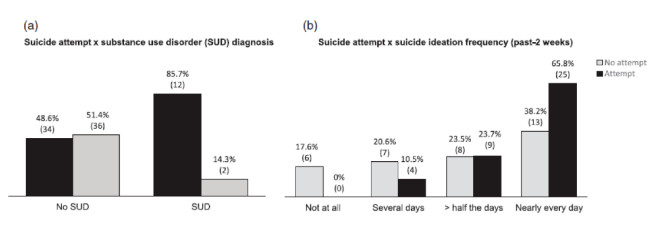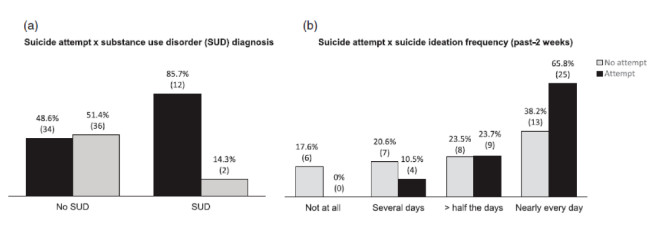"Severe and Complex Depression in Young People": Personal History and Clinical Features | Research Express
- Categories:News
- Author:
- Origin:
- Time of issue:2021-07-02
- Views:0
(Summary description)It is generally believed that depression is more common in women (≈ 2:1). However, among the 84 consecutive young patients with severe complex depression included in this study, the ratio of female to male patients was 1:1 (42 vs. 42).
"Severe and Complex Depression in Young People": Personal History and Clinical Features | Research Express
(Summary description)It is generally believed that depression is more common in women (≈ 2:1). However, among the 84 consecutive young patients with severe complex depression included in this study, the ratio of female to male patients was 1:1 (42 vs. 42).
- Categories:News
- Author:
- Origin:
- Time of issue:2021-07-02
- Views:0
Yimaitong Guide Reading
It is generally believed that depression is more common in women (≈ 2:1). However, among the 84 consecutive young patients with severe complex depression included in this study, the ratio of female to male patients was 1:1 (42 vs. 42).
54.8% of patients have significant social isolation; 59.5% have family conflicts; 36.9% are not currently in school or work; 36.6% of mothers suffer from mental disorders. The current proportion of patients with financial difficulties is only 26.2%.
84.5% of patients had experienced traumatic events; parental separation (51.2%) and bullying (38.1%) were common; 91.7% had suicidal ideation in the past 2 weeks, 54.8% had attempted suicide and reported overdose (44.0%) most. Substance use disorder (SUD) and multiple diagnoses are significantly related to the history of suicide attempts in this group.
55.4% of patients had a history of deliberate self-harm, and the proportion of female patients was significantly higher than that of males (71.4% vs. 39.0%). Incision injuries are the most common, with 50.6% of patients in the entire sample having such behaviors, and the proportion of female patients is also significantly higher than that of males (61.9% vs. 39.0%, p=0.037).
The main symptoms of depression are common throughout the sample. Among them, the report rate of depression was the highest, reaching 95.8%; the report rate of psychomotor agitation/delay was the lowest, but it also reached 73.2%. The gender difference in depressive symptoms is generally not obvious.
In recent years, the spectrum of mental disorders is undergoing significant changes. For example, depression in adolescents and young adults seems to be more and more common in clinical practice. A considerable number of patients have complicated conditions, high severity, and difficult treatments. They even formed a special concept, namely "severe and complex depression in young people." youth depression).
Based on DSM-5, the severe and complex depression of young people can be simply classified as major depression, but this classification does not fully reflect the particularity and complexity of the actual treatment. Such patients may have some common clinical and personal characteristics, which in turn can help guide individualized treatment, but there have been few studies on this topic before.
Research Introduction
The Mood Clinic (YMC) of the Youth Mental Health Center of the University of Melbourne, Australia provides integrated treatment for young patients with mood disorders, including psychiatric evaluation, multidisciplinary psychotherapy, caregiver participation, crisis planning, etc., to promote symptom improvement and functional recovery, and then It provides an important platform for the innovation of this group of treatment methods.
Recently, a group of Australian researchers reviewed 84 young patients with severe and complex depression who had been discharged from YMC consecutively, aiming to explore the key clinical and personal history characteristics of this population and provide clues for the innovation of intervention methods. This study was published in Early Interv Psychiatry. on June 25. The following is a brief introduction to the research findings:
Demographic and personal history characteristics
The only entry criteria for the study was discharge from YMC from January to June 2018. All patients were between 15-25 years old, the average age was 18.9 years old, and the average baseline PHQ total score was 19.19 (SD=6.35).
It is generally believed that depression is more common in women, female:male ≈ 2:1; however, in this study, the sex ratio of consecutively enrolled patients with severe and complex depression is 1:1 (42 vs. 42).
Table 1 Pre-morbidity and enrollment characteristics of 84 patients
(Rice, S. M. et al. 2021)

In terms of demographic characteristics, 54.8% of patients had obvious social isolation, while the proportion of male patients was significantly higher than that of female patients (70.7% vs. 39.5%, p=.004); 59.5% of patients had family conflicts; 36.9 % Currently have no formal schooling or work; 36.6% of patients’ mothers suffer from mental disorders. It is worth noting that the current proportion of patients with financial difficulties is not high, only 26.2%.
84.5% of patients have experienced traumatic events. Parental separation (51.2%) and bullying (38.1%) are more common. 15.5% of patients had experienced sexual abuse 2 years ago or earlier, and the proportion of female patients was significantly higher than that of male patients (25.6% vs. 4.9%).
55.4% of patients had a history of deliberate self-harm, and the proportion of female patients was significantly higher than that of males (71.4% vs. 39.0%, p=0.003). In terms of self-injury methods, incision injuries are the most common. In the entire sample, 50.6% of patients had such behaviors. The proportion of female patients was also significantly higher than that of males (61.9% vs. 39.0%, p=0.037).
91.7% of patients had suicidal ideation in the past 2 weeks, 54.8% had attempted suicide, and overdose (44.0%) reported the most. There is no significant difference between male and female patients in terms of suicide-related concepts and behaviors.
In terms of treatment routes, the proportion of patients referred from the emergency department of the hospital was the highest (31.0%). 72.6% of patients had previously received psychiatric treatment, and 51.2% were prescribed antidepressants before entering YMC.
symptoms and diagnosis
The main symptoms of depression, including low mood, anhedonia, sleep disturbance, fatigue, appetite disturbance, guilt/guilt, difficulty paying attention, psychomotor agitation/retardation, suicide/self-harm are common in the entire sample. Among them, the report rate of depression was the highest, reaching 95.8%; the report rate of psychomotor agitation/delay was the lowest, but it also reached 73.2%. The proportion of female patients with guilt/guilt was significantly higher than that of male patients (100% vs. 81.1%, p=.007), and there were no significant gender differences in other symptoms.
Common baseline diagnoses in this sample include mood disorders (89.3%), anxiety disorders (32.1%), substance use disorders (SUD, 16.7%), neurodevelopmental disorders (11.9%), etc. Comorbidities are common, and the proportions of patients with two, three, and four diagnoses at the same time are 48.8%, 25.0%, and 13.1%, respectively.
As mentioned above, 54.8% of patients have attempted suicide. Among the 11 patients with diagnosis number ≥4, 10 (90.7%) had attempted suicide; among the other 73 patients with diagnosis number 1-3, the proportion was 49.3% (p=.010).

Figure 1 The relationship between attempted suicide and substance use disorder (SUD) and the frequency of suicidal ideation in the past two weeks (Rice, S. M. et al. 2021)
Among patients with SUD, 85.7% have attempted suicide. Analysis shows that this proportion is 6 times that of patients without SUD (OR=6.35, 95%CI 1.32-30.49, χ2(1.84)=6.50, p=.011). In addition, patients who had attempted suicide had a higher percentage of suicidal ideations when they were admitted to the hospital.
discuss
The analysis of this continuous sample showed that the male to female ratio of young patients with severe complex depression was 1:1, one-third (36.9%) did not go to school or employment, a history of traumatic events (84.5%), and suicidal conceptions in the past 2 weeks ( 91.7%) and attempted suicide (54.8%) are quite common; the reporting rate of various depressive symptoms is very high, and the gender difference is not obvious. SUD and multiple diagnoses are significantly related to the history of suicide attempts in this group.
The above results have brought some enlightenment to the treatment. For example, experiencing traumatic events, social isolation, not going to school or employment, etc. are all harmful to interpersonal relationships. For young patients with severe and complex depression, YMC's conventional treatment model is influenced by cognitive behavioral therapy (CBT); however, practical experience shows that CBT with or without drug therapy is not enough for many such patients. YMC is exploring many combined intervention methods, some of which focus on understanding and improving the functions of young patients in interpersonal relationships, such as learning from certain methods of cognitive analysis therapy, interpersonal therapy, and narrative psychotherapy. In addition, YMC is also trying new biological treatments, including low-dose ketamine and transcranial magnetic stimulation.
This study further emphasizes the treatment needs of young patients with severe and complex depression. However, limited by research information, this study cannot verify the validity of the concept of severe and complex depression in young people. In any case, increasing attention to the complex treatment needs of this patient group will help reduce their suffering and functional damage, and reduce the risk of suicide.
Literature Index:
Rice, S. M., McKechnie, B., Cotton, S., Brooker, A., Pilkington, V., Youzchalveen, B., Schmaal, L., & Davey, C. G. (2021). Severe and complex youth depression: Clinical and historical features of young people attending a tertiary mood disorders clinic. Early Intervention in Psychiatry, 1–7. https://doi.org/10.1111/eip.13183
Scan the QR code to read on your phone
Jiangsu Healsun Meical Co., Ltd.
Tel:025-86669187
e-mail:Office@Healsun.com
Address:Room 1616, Building F1, Intercity Space Station, No. 12 Jinlan Road, Jiangning District, Nanjing, China
WeChat public account
Jiangsu Healsun Meical Co., Ltd. 苏ICP备19029369号-3





